

G. Kim Wincup, Staff Director,
Committee on Armed Services,
House of Representatives

Senator John Tower (R-TX),
Chairman, Senate Armed Services Committee

Mack Fleming,
Staff Director and Chief Counsel,
Committee on Veterans’ Affairs,
House of Representatives

Representative Ron Dellums (D-CA),
Member, House Armed Services Committee

Representative Melvin Price (D-IL), Chairman,
House Armed Services Committee

Senator Sam Nunn, (D-GA), Ranking Member,
Senate Armed Services Committee

Senator Alan Cranston (D-CA),
Ranking Member,
Senate Veterans’ Affairs Committee
SONNY’S SUMMARY
The 31 House-Senate conferees accepted neither the New GI Bill provisions of H.R. 1400 approved by the House in its version of the DoD Authorization Act nor the version approved by the Senate in the New GI Bill Program amendment. The wee-hours Conference Committee produced a compromise three-year, statutory test program in which service members would contribute $100 per month for 12 months so as to become eligible for 36 months (four academic years) of post-service education benefits at $300 per month. Eligibility for the New GI Bill was limited to service members entering the military between July 1, 1985, and June 30, 1988.
Highly fatigued conferees ate readily available M&M’s® daily to augment their energy levels. Conference Chairman John Tower scheduled the conference’s vote on a GI Bill provision last, following weeks of hard negotiating over the $211 billion defense authorization bill. The bill included provisions for the MX missile, the B-1B bomber, the Pershing missile, the Trident submarine, the Strategic Defense Initiative (known pejoratively as “Star Wars” in some quarters), and anti-satellite weaponry.
At the conclusion of the conference, professional staff of the House and Senate Veterans’ Affairs and Armed Services Committees even found themselves in disagreement about what they had agreed to regarding a New GI Bill—prolonging the strained relationship on this issue.

Mr. Montgomery
I’ll ask Mr. Kim Wincup, who served on the staff, including as majority staff director of the Committee on Armed Services, U.S. House of Representatives, from 1974 through 1984, to comment further on setting the scene for you, our students.1
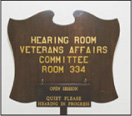
Then I’ll ask Mr. Mack Fleming to help describe the conference. Mack served on the staff of the House Committee on Veterans’ Affairs from 1974 to 1994, including 14 years as majority staff director and chief counsel.2
Mr. Wincup
“Thank you, Mr. Chairman.
“First, by way of background, the annual DoD Authorization Act is one of the most important bills Congress considers each year. The House-Senate conferees authorized funds of $211.7 billion for fiscal year 1985; $12.8 billion below the President’s budget request.3

Kim Wincup
“House conferees are known as ‘Managers on the Part of the House’ and Senate conferees as ‘Managers on the Part of the Senate.’ “It was a big bill. The report on H.R. 5167—the House’s version of the FY 1985 DoD Authorization Act—filed by the House Armed Services Committee on April 19, consumed 399 pages.4 The May 31 report filed by the Senate Armed Services Committee on its version—S. 2723—filled 527 pages.5
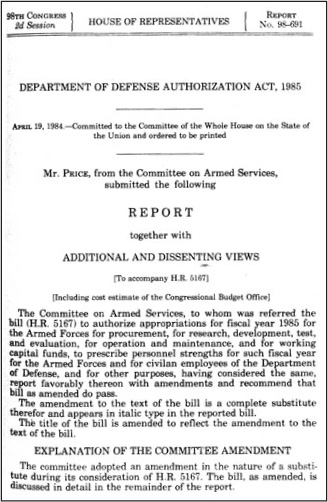
The House Report
“Second, before we got to the House-Senate Conference, the full House had debated H.R. 5167, on May 15, 16, 17, 23, 24, 30, and 31.6 It was unusually contentious, with members at times shouting at one another during the debate on thermonuclear weapons systems, for example.7
“Students, during tense times on the House floor, I can say to you that Representative Sonny Montgomery was often a calming force because—based on what I saw—both sides of the aisle respected him.8 He typically was like an island of reason in a sea of dispute when things boiled over.9
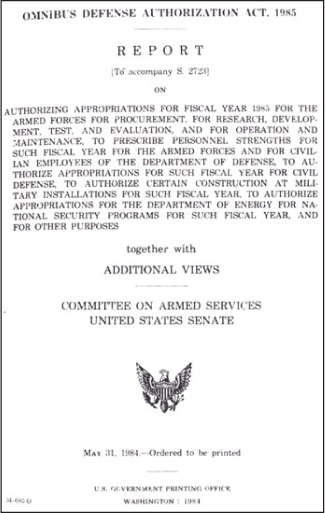
The Senate Report
“By the time of the House-Senate Conference, we on the House side had already expended considerable energy and emotion on this $211 billion bill just to formulate a House position. I suspect a similar dynamic existed in the Senate as the Senate debated its bill, S. 2723, on June 7, 8, 11, 12, 13, 14, 15, 18, 19, and 20.10 As you know, the Senate debated the Glenn and Armstrong New GI Bill amendment on June 11 and 13 for about nine hours.
“Third, the Democratic party was in the majority in the House, and the Republican party was in the majority in the Senate during this period of the Ronald Reagan presidency. Our work was challenging because not only the two political parties—but also the two chambers of Congress themselves—had very different philosophies on how best to use funds for our national defense. It seemed as if even the smallest difference of opinion could magnify itself into something larger.
“Fourth, members were worn out. The 31 members of the House-Senate Conference Committee on the FY 1985 DoD Authorization Act11 had been working daily for about two weeks on resolving major differences between the House- and Senate-passed bills.
“Conferees and staff painfully worked through heavy-duty issues to authorize funds in the tens of billions of dollars for programs such as the MX advanced intercontinental ballistic missile system, the B-1B bomber program, the Pershing II missile program, the Trident ballistic missile submarine program, various cruise missile programs, the space-based Strategic Defense Initiative, and anti-satellite weaponry, to name just a few.12
“The compromise legislation that the House and Senate ultimately approved and sent to the White House consumed 176 pages and the report issued by the conference managers 354 pages.13
“Fifth, we had been living on M&M’s® much of the time. Can you believe it?
“The Mars Corporation, producers of M&M’s®, was located in the rural Virginia Congressional district of Representative Dan Daniels. Mr. Daniels was a member of the Conference Committee and kept conferees and staff alike supplied with the M&M’s® to sustain us the many times we worked late into the evening or early-morning hours.

Late-night energy food for the conferees.
“Sixth, as Chairman of the Conference Committee, Senator Tower scheduled discussion of a New GI Bill last, because he was unconvinced the legislation was necessary.14 But he knew he’d probably have to accede to the House’s wishes in some way.15
“Seventh, because there were 42 conferees during discussion of the New GI Bill provision,16 we met in room S. 407 of the main Capitol.
“Last, with respect to substantive policy, there was no real voter constituency for the New GI Bill issue. Does this surprise you?
Across the country, Americans understandably were focused on the business of going to work every day, raising families, and participating in their local communities. The military budget was not necessarily an issue they followed closely. And if they did follow it, it often was because of the high-technology weapons systems that made the newspaper headlines.
“So Mr. Montgomery and a handful of his colleagues in the House and Senate—with help from the civilian and military leadership of the Army, the Non Commissioned Officers Association, the Fleet Reserve Association, and others—had to make the case for spending money, however little, on a New GI Bill that represented a paradigm shift from previous GI Bill programs. Senator Simpson talked of this paradigm shift extensively in the Senate debate in Chapter 8.17
“That’s the dynamic I saw at work as we entered the House-Senate Conference.
Mr. Montgomery
Thank you, Kim.18
What we see depends on where we sit. So I’d just add four small points to Kim’s good observations, as background to the conference.
First, as I mentioned at the end of Chapter 5, the House Armed Services Committee (HASC) could have brought H.R. 1400—designed to create a New GI Bill—to the House floor in 1982 for a vote as a stand-alone, “clean” bill. Instead, in 1984, HASC leadership elected to include the provisions of H.R. 1400 in the massive Fiscal Year 1985 DoD Authorization Act—again, instead of as a stand-alone bill.
Second, when Mack Fleming saw the conferee list furnished by Speaker Tip O’Neill’s office on about June 23,19 he noticed the Armed Services Committee had 13 conferees—seven Democrats and six Republicans—and the Veterans’ Affairs Committee had none.20 So he immediately informed me.
I went directly to Speaker O’Neill and asked him to appoint a more equal number of conferees from the two committees.21 On June 25, the House concurred without objection that the Speaker add nine conferees from the Veterans’ Affairs Committee for the discussion on the New GI Bill part of the conference.22 So students, if you don’t ask, the answer is no!
These conferees are informally known as “outside conferees,” meaning they come from a committee other than the committee having primary jurisdiction on a bill. Five new conferees were Democrats and four were Republicans.23
I never hesitated on requesting conferees be appointed from the Veterans’ Affairs Committee because the New GI Bill provisions in H.R. 5167 were derived from H.R. 1400 that the Veterans’ Affairs Committee had approved in 1983. The Parliamentarian of the House indeed had referred H.R. 1400 jointly to both committees.24
Third, I obtained proxies25 signed by House Veterans’ Affairs Committee conferees from both sides of the aisle who could not be present at the final late-night session. Fourth, House Armed Services Committee Chairman Melvin Price asked me to manage the negotiations for the House on the New GI Bill aspect.26

Proxies were obtained for those who could not be present at the final, late-night session. This sample is from another conference.
I knew the negotiation with the Senate would be a challenging one, and he wanted to be able to lead the discussion on behalf of the House team, just as Chairman Tower would lead the negotiation on behalf of the Senate team.
Mr. Montgomery
None of us had eaten supper and I was so hungry I felt I could eat a folded tarp!27 So the Pentagon sent in boxes of “meals-ready-to-eat” for the hungry conferees.28
Known as “MREs,” these are the meals soldiers eat when they are deployed in the field.
I did not want conferees to leave the conference for supper because I didn’t want to give Chairman Tower time to round up more votes in support of his position.29
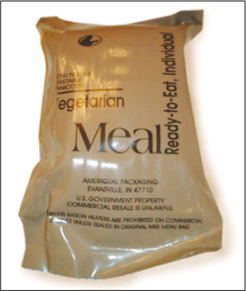
Sonny brought in MREs to feed the conferees so they wouldn’t break for supper and allow Chairman Tower to potentially round up more votes. This is a current-day version of a MRE.
As Kim Wincup said a minute ago, Chairman Tower scheduled consideration on the House and Senate provision relating to a New GI Bill as the very last item to be negotiated. At various times during that final evening of the conference, I asked Chairman Tower when he thought the conference would discuss this issue. As I remember it, at one point our brief exchange went like this:
Mr. Tower
“We’ll get to it. You’ll be all right on this. You don’t need to worry.”30

John Tower
Mr. Montgomery
“Oh, I know I’ll be all right, Mr. Chairman (as I patted an envelope in my breast pocket of signed proxies from House conferees who had to depart due to the lateness of the hour).”31 All present in the room knew I had a sufficient number of signed proxies to control the issue on the House side.
So how did it play out? Let me turn to Staff Director and Chief Counsel Fleming.
Mr. Fleming
“When John Tower and Sam Nunn would make a proposal, at times our own House conferees would huddle around Chairman Montgomery as we caucused privately and would say, ‘Take it, Sonny, take it!’ I think some of our folks were concerned we’d end up with nothing at all.32

Mack Fleming
“And then the passionate Representative Ron Dellums33 would say to our House conferees, who were still huddling, something like the following:”
Mr. Dellums
“Just make the House proposal to Chairman Tower on our behalf, because if you propose it, Chairman Montgomery, we’ll win.”34

Ron Dellums
Mr. Fleming
“Chairman Tower understandably called for votes of the conferees on the [House-passed New GI Bill proposal] with hopes of defeating it because he earnestly felt it unnecessary for the reasons he articulated in opposition to the Armstrong amendment.35
“And then, still in the huddle, Mr. Dellums repeatedly would exhort our House conferees with something like the following:
“‘Let’s just have Chairman Montgomery handle this directly and we’ll prevail.’”36
Mr. Montgomery
I was confident. For each vote, I would take the proxies given to me [by House conferees who were not present] and vote them. Each time the House would insist on its position.37 Mr. Tower said to me more than once during the negotiations words something like these, followed with the one-time response from Mr. Dellums:
Mr. Tower
“Congressman, I am prepared to go back to my colleagues in the Senate telling them the House and Senate have no deal on the DoD Authorization Act because the House insists on a New GI Bill. Chairman Montgomery is holding up the entire bill because of his insistence on this one provision.”38
Mr. Dellums
[Pointing his index finger toward Chairman Tower].
“Help the brother out here, Senator, help the brother out!”39
Mr. Montgomery
After many votes, I suggested the following to Chairman Tower:
“Maybe I had made a mistake in the logo we designed for the GI Bill we [the House] supported. Rather than a logo consisting of a cap and gown, I should have placed the education provisions in a cylinder with a nose cone at the front and a fuse in the back so that it looked like a missile that would destroy a convoy of ammo trucks, and then it would pass.”40
I also reminded everyone that education benefits for military personnel would enhance lives upon leaving service. Further, I noted that GI Bill benefits had been carefully analyzed and shown to be the very best incentive for recruiting and retaining quality personnel.41
The Senate conferees from the Armed Services Committee were not willing to agree with the position of the House—and vice versa.
Before we could get a positive move by Senator Tower, we had to accept his very strong view (by Senators Nunn, Glenn and others) that any service member who participated in the New GI Bill could do so only by agreeing to have $100 per month for 12 months deducted from his or her pay. No such requirement appeared in the legislation passed by the House.42
As you remember, the Glenn amendment that passed the Senate in Title VII of the FY 1985 DoD Authorization Act had a $250-per-month service-member contribution.
And I was thinking to myself, “That dog won’t hunt!”43 We couldn’t accept a pay reduction, including $200 per month.
In any case, with the strong support of Senators Bill Cohen of Maine and Alan Cranston of California and my fellow conferees from both the Armed Services and Veterans’ Affairs Committees of the House, we prevailed in conference. Senator Tower relented, and we all thought we had reached full agreement on the new, permanent GI Bill for the All-Volunteer Force.44

U.S. Capitol
At about 2 a.m.45 on September 25,46 the staff from the House and Senate Armed Services and Veterans’ Affairs Committees met with the legislative counsels of the House and Senate in the basement of the Cannon House Office Building to work out all technical aspects of the bill.47 The basement of the Cannon building is where the House Office of Legislative Counsel is located.
Legislative counsels are the attorneys who draft legislation. They work for the Office of Legislative Counsel in both bodies and not for the individual committees or individual members of Congress. They are invaluable.48 They draft into legislation the language that conferees agree to.

Karen Heath of the Democratic side of the House Armed Services Committee and Patrick Tucker of the Republican side of the Senate Armed Services Committee looked over Assistant Legislative Counsel Bob Cover’s shoulder as he drafted into legislative language that Ms. Heath and Mr. Tucker told him the conference agreed to.49
Mr. Cover diligently completed the legislative drafting at about 3:30 a.m.50
However, to the surprise of the majority and minority staffs of both the House Veterans’ Affairs and Armed Services Committees, and Senator Cranston, the ranking member of the Senate Veterans’ Affairs Committee,51 something changed. Now the staff was told their members had only agreed to accept the New GI Bill as a three-year “test” program.
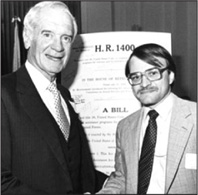
Sonny and Bob Cover after the enactment of the New GI Bill provisions (H.R. 1400).
That was news to me when my chief counsel and staff director, Mack Fleming, awakened me at home with this information. At that hour, with the conference agreement going to the floor for a vote that morning, there was little chance of calling the members back to resolve the issue.52
I asked Mr. Fleming to meet with the House Armed Services Committee staff that morning so we could be assured the three-year “test” position taken by the Senate Armed Services Committee staff was not what we had agreed to and that the House Armed Services Committee would continue to support us in making the GI Bill permanent.53 We learned that House Armed Services Committee staff’s recollection was the same as our staff’s, but there was no time to have the Conference Committee re-visit the issue.
Plus, on a smaller issue, House staff thought that we had agreed to repeal VEAP, but the Senate conferees thought we hadn’t.54
As I recall, Mack informed the Senate staff that “tonight you may have won the battle on this issue, but you will lose the war when Chairman Montgomery moves to correct it.”55 And it would take us until 1987 to make the New GI Bill permanent public policy. The House adopted, in Conference, the 354-page Conference Manager’s Report on H.R. 5167 on September 26, 1984,56 and the Senate on September 27, 1984.57
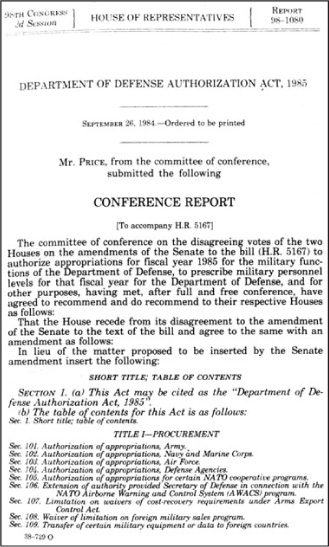
The Conference Report
In bringing the manager’s report to the House floor, Armed Services Committee Chairman Price observed the following:58
Mr. Price

Melvin Price
“The conference on this bill has been the most difficult one I have ever experienced. The conferees struggled with resolution of the two sides’ positions with respect to the MX missile, as well as testing of the anti-satellite weapon and other important defense questions and, in addition, a large number of general provisions….
“The conference broke up in late July when no agreement could be reached on resolution of the MX missile issue and overall funding levels. The House conferees felt they could not accept the uncompromising position offered by the Senate. The conference was in recess for almost a month and a half before negotiations between the Speaker and the majority leader of the Senate produced an agreement on these issues. When this agreement was reached, the conference was reconvened, and this Conference Report is consistent with the agreement negotiated by the Speaker and the majority leader of the Senate with respect to MX and overall funding.
“For the MX, funds are authorized at a level of $2.5 billion for fiscal year 1985. However, only $1 billion of those funds may be spent for deployment of the missiles authorized in fiscal year 1984 and for certain long-lead requirements and spare parts for the fiscal year 1985 program. The remaining $1.5 billion is fenced until the Congress approves, through a joint resolution, expenditure of the funds for the procurement of 21 MX missiles in fiscal year 1985 in a vote to occur in March.”
Mr. Montgomery
I, too, had not experienced a conference as difficult as this one.59
In the Senate, John Tower, Sam Nunn, and Alan Cranston spoke when the conference report came to the floor for a vote.
First, Senator Tower spoke regarding the entire DoD authorization bill, as Representative Price had done on the House side:60
Mr. Tower
“We started conference on this bill with the House on Friday, June 22, in the absence of a first concurrent resolution on the budget. In effect, we were working with different budget figures on how much should be spent for defense. The conferees worked diligently through several sessions to complete their work prior to the August recess.
“However, it became obvious that without a resolution of the budget figures for national defense and without some resolution of the issue of how to proceed with the MX missile system, it would be impossible for the conferees to complete work on this important defense bill.
“As a result of this impasse, leadership from the Senate and the House of Representatives undertook a series of negotiations which were finally completed on Thursday, September 20. Since that time, we have been able to complete Conference action on the defense bill.”
Mr. Montgomery
Then Mr. Nunn spoke:61
Mr. Nunn
“Mr. President, one of the toughest issues facing the conference was the question of a new program of educational incentives for military service.
“The House contained a new GI entitlement program for everyone entering military service sponsored by Congressman Montgomery. The Senate bill contained a much more limited program of educational benefits, introduced by Senator Glenn, designed to appeal to high-quality, motivated recruits who would come into service for one enlistment in return for a college education.

Sam Nunn
“The conferees agreed to a three-year test program in which all members entering active service for three years beginning July 1, 1985, will be eligible to receive post-service educational benefits in return for a reduction in pay of $100 per month for the first 12 months of active duty….
“I stress my belief that the conferees intend this strictly as a test-program, although it is far too large a test for my own appetite.
“Notwithstanding my opposition to this particular provision, I want to pay special tribute to the hard work and effective leadership in this area by Congressman Montgomery, Senator Cohen, and Senator Armstrong, who are committed to ensuring we obtain the high quality of recruits we need today. They have spearheaded the effort for a peacetime GI Bill. While we do disagree on the approach, I think we all agree on the final goal.”
Mr. Montgomery
Then Senator Tower, again: 62
“Mr. President, I am bound to say that I am very much in sympathy with what the Senator from Georgia said, and I share his concerns and would have preferred to see nothing of this type in the bill.
“I felt it was necessary to try to effect some sort of compromise with the House of Representatives in the interests of getting out a Conference Report, and it was under that kind of situation that I did agree to a somewhat more limited GI Bill than what was originally proposed in the House bill, but I must say I do share the concerns of the Senator from Georgia.”
Mr. Montgomery
Finally, Senator Cranston: 63
Mr. Cranston

Alan Cranston
“… I am pleased that the Conference Report that is now pending before the Senate contains provisions—Title VII—that would establish a new All-Volunteer Force Educational Assistance Program.
“Regrettably, there is one element of the package with which I am particularly unhappy and that is the status of the current VEAP program. Under the provision in the Conference Report, that contributory-matching program would not be repealed—as had been proposed in the House-passed legislation and in the amendment I had joined in offering in the Senate—but rather, it would be, in essence, ‘suspended’ for new entrants during the period July 1, 1985, through June 30, 1988.
“Madam President, I am aware of the great concern expressed on the floor of the other body by my friend from Mississippi [Mr. Montgomery] about the insistence of the Senate Armed Services Committee that the VEAP program be suspended for three years rather than terminated, as the House bill provided.
“Mr. Montgomery had good reason to believe that the Senate had agreed to terminate VEAP, and I regret very much the way that this matter was handled and the outcome that Mr. Montgomery had to accept at the 11th hour in order to salvage the entire Conference Report… he was not treated properly on this issue.”
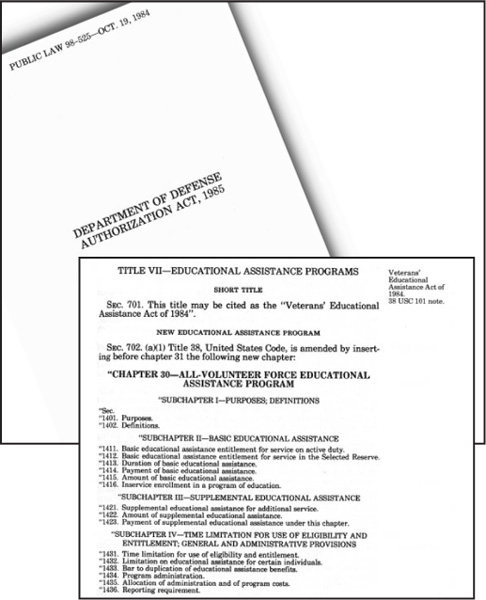
Title VII of Public Law 98-525
Mr. Montgomery
So the All-Volunteer Force GI Bill became law but was limited to a three-year test program and a $100-per-month pay reduction for 12 months. Nonetheless, I was confident the New GI Bill would eventually be made permanent within the so-called three-year test period. It would stand or fall on its own merits. 64
President Reagan signed the DoD Authorization Act into law on October 19, 1984, enacted as Public Law 98-525. 65
Let me reiterate that the three-year test New GI Bill we had to accept from the Senate in 1984 was quite different from H.R.1400, approved by the House Veterans’ Affairs Committee in 1981:
• First, as introduced and approved by my five House colleagues and me in 1981, we structured the program as an entitlement and required no reduction of basic pay of $100 per month for 12 months for service members to become eligible for the New GI Bill.
• Second, under H.R.1400, a service member on active duty at the time of enactment of the bill would have had the option of switching to the New GI Bill if he or she was eligible under earlier programs, such as the Vietnam-era GI Bill or VEAP;
• Third, the New GI Bill proposed in H.R. 1400 would have been established as a permanent program, not as a test program;
• Fourth, H.R. 1400, as introduced, would have permitted—under certain circumstances—service members to transfer their education benefits to their dependent children or spouses; and
• Fifth, H.R. 1400 would have terminated the VEAP program for new participants rather than suspended it.
My colleagues and I wanted the “full loaf” in the form of sending the substance of H.R.1400 to the President’s desk. But often we have to compromise in the short term in order to prevail in the long term.
As of July 1, 1985, the service branches began testing the New GI Bill. On June 24, 1985, I wrote a personal letter to each member of the House of Representatives telling them about it.66
After completing a three-year enlistment, the former service member would receive $10, 800 in education benefits—$300 per month for 36 months—from the VA.67 Remember, this is 1985, when the average annual tuition for a commuter student at a four-year public college was $1, 318.68
Folks, let me add a postscript to this chapter regarding proposed additional legislative amendments to the three-year GI Bill test program that I’d like you to know about.
It’s not something we’ll spend much time on, because Congress did not enact into law the provisions of either H.R. 752, the proposed Veterans’ Educational Assistance Eligibility Amendments of 1984; or section 522 of S. 1160, the proposed National Defense Authorization Act for Fiscal Year 1986.69
Both bills proposed amendments to the New GI Bill test program that Congress had just enacted into law a few months earlier on October 19, 1984.
Our H.R. 752 passed the House March 28, 1985.70
H.R. 752’s main provision (among three in all) would have extended New GI Bill eligibility to individuals with prior military service who return to active duty.71
A four-provision bill passed by the Senate Veterans’ Affairs Committee72 was generally the same as H.R. 752. But it included a slightly different provision regarding New GI Bill eligibility for service members with prior service who returned to active duty. The Senate Veterans’ Affairs Committee met in open session on April 18, 1985, and approved its bill.
The Senate Armed Services Committee73 sought and received a limited-time sequential referral of H.R. 752, as amended by the Senate Committee on Veterans’ Affairs.74 The Senate Armed Services Committee did not support any of the provisions of H.R. 752 in its report on S. 1160 filed August 1.75
The Senate Armed Services Committee amendments to the New GI Bill test program, as included in section 522 of S. 1160, contained provisions that would:
• Require a service member to have to opt-in to the New GI Bill test program instead of having to opt-out;
• Give a service member up to two years after signing up for the New GI Bill test program to withdraw his $1,200 to establish eligibility for the program, so as to gain $10, 800 in educational benefits (for those who changed their minds about participating); and
• Make certain changes to New GI Bill eligibility for service members already on active duty who reenlist.76
The full House and the Senate Committee on Veterans’ Affairs Committee did not support any of the Senate Armed Services Committee-passed provisions.77
So Congress enacted the provision of neither of those two bills into law.78
Though the House preferred a permanent New GI Bill rather than the three-year test program, when an informal team of legislators and persons/organizations external to the legislative branch work on legislation for about four years,79 it’s important to pause and celebrate the team’s efforts.
One of the more selfless acts I saw continually during some 40 years of public service was how organizations such as the Disabled American Veterans (DAV), Paralyzed Veterans of America (PVA), and Blinded Veterans Association (BVA) earnestly supported legislative proposals benefiting non-disabled Americans.
I found such support rather extraordinary because disabled veterans had their own version of the GI Bill through VA’s rehabilitation program.
In any case, working alone, I suspect none of us could have made even a New GI Bill test program happen because of the increased cost of the entitlement benefit. Elected Representatives and Senators, veterans’ service organizations, aspects of the higher education community, military personnel groups, selected executive branch officials, and reportorial interest of the Army Times all contributed in unique ways.
Here are just a few photos from our end-of-session gathering.80

Sonny with House Armed Services Committee staff members Karen Heath (center), and Kim Wincup as they celebrate H.R. 1400.
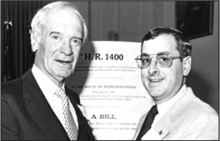
With NCOA Government Relations Director Dick Johnson…
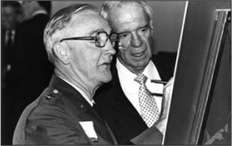
Lt. General Emmett “Mickey” Walker…
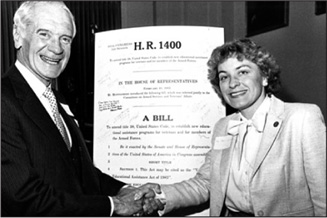
With Rep. Marcy Kaptur (D-OH)…
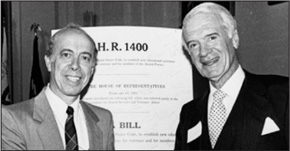
With HVAC staff member Mack Fleming…
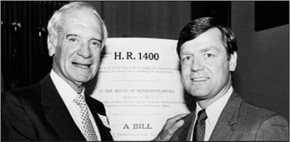
With Rep. Bob Edgar (D-PA)…
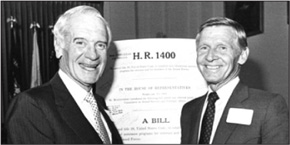
With Rep. Bob Stump (R-AZ)…
Sonny and House Committee on Veterans’ Affairs staff: from left, Jill Cochran stands next to LTC Joe Selman; then Mack Fleming and Frank Stover.
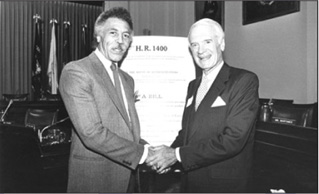
Sonny with Rep. Ron Dellums (D-CA).
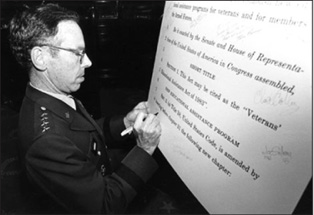
General Max Thurman signs the H.R. 1400 replica.
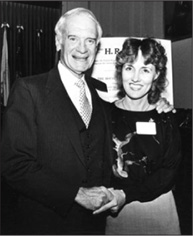
With House committee staffer Candace Sniffen…
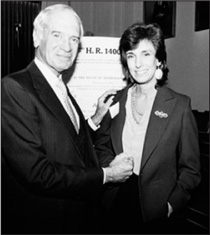
With Julie Susman of the Senate Committee on Veterans’ Affairs…
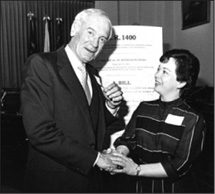
With House committee staffer Beth Kilker…
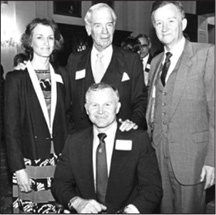
Back row, from left, Betty Ann Colley, Sonny and Rep. John Paul Hammerschmidt (R-AK); in front, Chad Colley of the DAV.
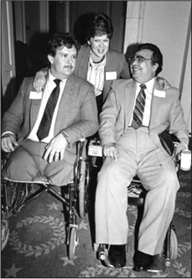
From left, Bob Moran of the PVA; (unidentified) and Frank DeGeorge of the PVA.
Folks, go for the full loaf in your ideas. But if you don’t get it, don’t go away mad. Take half a loaf—as we did in the three-year New GI Bill test program. Come back the next time, and get the
other half. We often have to compromise in the short term in order to prevail in the long term.
WHAT’S NEXT
In the next chapter we’ll discuss the departments of Veterans Affairs and Defense implementing the test program.81